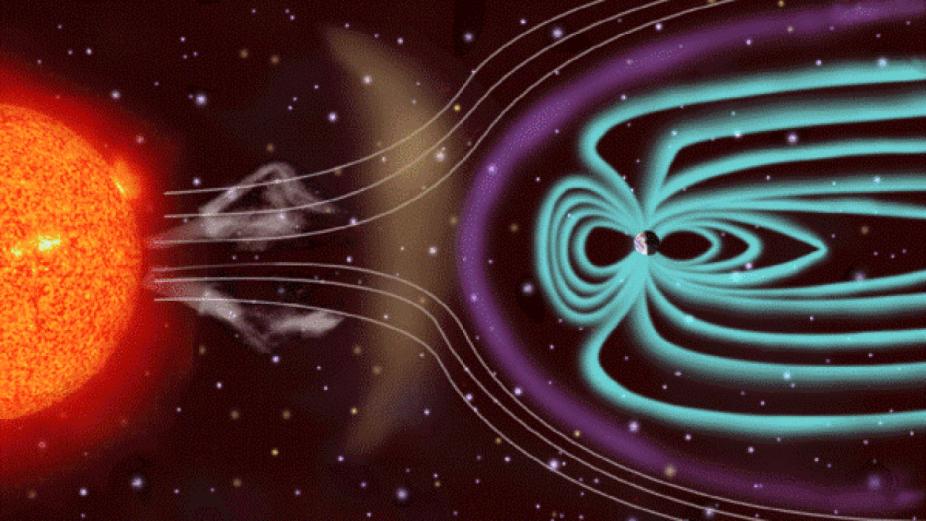Solar-Terrestrial Interactions
The correlation between sunspot number and auroral sightings (slide 17) hints at a possible relationship between solar activity and some aspects of geomagnetism and atmospheric dynamics. This important area of research goes under name of solar-terrestrial interactions.

Solar-Terrestrial Interactions
Solar astronomers of the nineteenth century rapidly recognized that strong flares or other intense activity observed on the Sun were often followed, minutes later, by disturbances in magnetic instruments on Earth. Large flares and coronal mass ejections often trigger geomagnetic storms; coronal material blown outward from the Sun at speeds exceeding that of the normal quasi-steady solar wind steepens into shocks, which pass by the Earth, interacting with and perturbing the Earth's magnetosphere. The most common (and spectacular) manifestation of geomagnetic storms is the occurrence of Aurorae Borealis and Aurorae Australis (the so-called Northern and Southern Lights). More disruptive effects include perturbation of radio communications, disruption of power grids, and enhanced orbital decay of low orbiting satellites. However, in view of their transient character, such events are not believed to induce long lasting variations in the climatic system, unless their frequency of occurrence were to change dramatically over extended periods of time.
Changes in the solar luminosity represent the most obvious way to effect climatic variability on Earth. Because sunspots are darker than their surroundings (slide 1 and slide 3), and given the dramatic variations in sunspot area coverage through the solar cycle (slide 18), one may expect a corresponding decrease of the solar luminosity with increased sunspot coverage. In fact, the Sun is very slightly brighter near sunspot maximum, possibly because (darker) sunspots and active regions are often surrounded by (brighter) plages (slide 2). However, certain portions of the solar spectrum, in particular the ultraviolet, vary rather drastically throughout the solar cycle. Even though ultraviolet radiation contributes very little to the total radiative output of the Sun, consequences for the Earth's climate can nevertheless be significant, as the chemistry and energy balance of the upper atmosphere (altitudes of ~ 50 km and up) are largely driven by the flux of solar ultraviolet radiation. As it turns out, the time period 1645–1715 corresponding to the Maunder minimum in sunspot number (slide 17), occurred during an extended time period of severe winters and overall cold weather in western Europe, which is sometimes referred to in the climatic literature as the "little ice age."
There exists a number of less direct way to ascertain the level of solar activity prior to the beginning of telescopic sunspot monitoring in 1610. Comparison of historical records of auroral sightings with sunspot numbers reveal a striking correlation between the amplitude of sunspot cycles and the frequency of (recorded) auroral sightings. In particular, very few aurorae were reported in northern Europe during the time period corresponding to the Maunder minimum. Auroral sightings have been reported as far back as 500 B.C., but the records are extremely sparse up to about 1000 A.D. and are truly reliable only for the last 400 years or so. Nevertheless, if taken at face value these data indicate that prolonged epochs of low auroral activity, similar to the Maunder minimum, have occurred at earlier epochs, in particular in 1420–1500 (the so-called Spörer minimum) and 1290–1340 (the Wolf minimum).
The production of the isotopes beryllium 10 and carbon 14 are known to be sensitive to the intensity of galactic cosmic ray bombardment in the upper atmosphere of the Earth. The flux of cosmic rays at the Earth's orbit, in turn, is known to decrease with increasing solar activity. The abundance of 10Be and 14C, as determined respectively from polar ice cores and tree rings, shows pronounced increases around the times of the Maunder, Spörer and Wolf minima. A significant drop of the 14C abundance in 1100–1250 A.D., possibly associated with a period of abnormally high solar activity, roughly coincides with a period of warming in Medieval Europe, and of generalized drought in North America, as evidenced by the demises of the Anasazi culture in the second half of the 13th century. From the modeling standpoint, the situation is complicated by the need to account for purely geomagnetic effects (the Earth has its own aperiodic magnetic cycle, characterized by epochs of field reversal with period of order 104–105 yr, and other epochs of fixed magnetic polarity lasting 106–107 yr). The situation is further complicated by various uncertainties associated with transport and deposition of contaminants in the Earth's atmosphere, and with the dynamics of the global atmospheric carbon cycle. Nevertheless, while the physical link(s) between the solar cycle and large-scale climatic patterns remains elusive, such striking correlations are suggestive of a causal relationship.
The Sun has been around more or less in its present form for four and a half billion years, and has another five billion years or so to go before it exhausts its supply of Hydrogen to becomes a red giant. In doing so the Sun will inflate to about 50 times its present size, engulfing Mercury and incinerating Venus and Earth in the process. Later evolutionary phases will see the Sun swell up to ~ 300 times its present size, but by then there will most likely be no spectators left on Earth to witness the event. The evidence reviewed above, however, strongly suggests that we should not wait 5 billion years before starting to pay attention to what the Sun is doing.